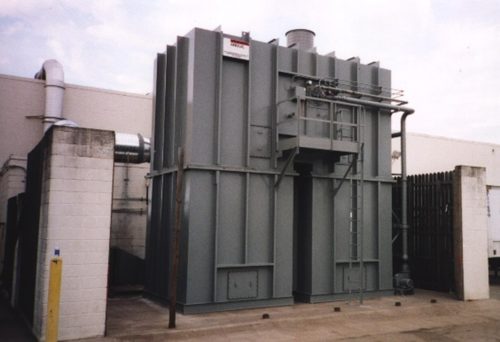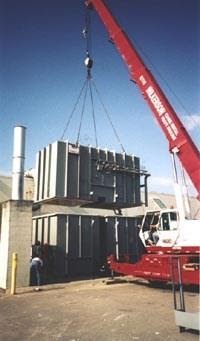 The Challenge
The Challenge
Control of air emissions has become an important issue that flexible packaging converters must consider when changing or upgrading equipment. A producer of printed shrink films, bags and pouches for a diverse range of applications addressed its emissions in 1991 and 1996 by investing in two Anguil catalytic oxidizers to control the EPA-regulated air emissions generated in their various processes.
But when the company decided to purchase a new 10-color gearless press to increase capacity and capability years later, management knew they also needed to determine if an alternate technology would reduce their operational costs compared to their two catalytic oxidizers.
The Solution
Having supplied the original catalytic oxidizers, the customer contacted Anguil Environmental to analyze the most cost-effective and compliant way to replace the two aged systems. After an analysis, Anguil recommended replacement of the existing equipment with a single 25,000 Regenerative Thermal Oxidizer (RTO).
The Result
RTOs Replace Catalytic Oxidizers
Though the catalytic units were a logical choice at the time of purchase, technological advances in the ensuing years had caused the RTO to become a much more viable abatement strategy.
Now 15-20 years following the original catalytic oxidizer installations, the customer and Anguil’s objectives were to:
- Achieve destruction of 98 percent of the Volatile Organic Compounds (VOCs) in the press exhaust
- Fit the system into limited space
- Complete the tear-out and subsequent installation in just six days
The operation of the RTO is considerably different from the existing catalytic units. The oxidizer consists of two reinforced, insulated chambers filled with high temperature structured ceramic energy recovery media. The oxidizer utilizes a burner to maintain the oxidation temperature. Located beside the energy recovery chambers are diverter valves and air duct plenum passages, which allow the press exhaust to be diverted into and out of the oxidizer in either a clockwise or counterclockwise mode. The directional mode is controlled by a PLC, which changes the direction of airflow at regular intervals to optimize system efficiency.

In operation, solvent laden air (SLA) enters the oxidizer via an energy recovery chamber where the high temperature ceramic heat transfer media preheats the SLA prior to introduction into the oxidation chamber. As the SLA passes up through the bed, its temperature rapidly increases. After the chemical oxidation purification reaction occurs, the hot, clean, outgoing gas heats the exit energy recovery bed. In order to maintain optimum heat recovery efficiency, the SLA flow direction is switched at regular intervals by the automatic diverter valves on demand from the PLC control system. This periodic flow direction shift provided a high thermal efficiency to minimize customer operational cost.
With sufficient concentration of hydrocarbons in the process air stream, the heat energy content of the VOCs will result in self-sustained operation with no auxiliary fuel usage.
Features that are specific to the RTO include:
- High volumetric turn-down capability, enabling the control of multiple presses and the reduction of operating cost.
- Thermal energy recovery of 95 percent or higher, allowing self-sustaining operation with no auxiliary fuel usage at levels as low VOC exhaust concentrations..
- Customized thermal energy recovery media, providing low-pressure drop and low electrical cost.
Anguil’s vast experience, gained after supplying more than 2,000 successful systems around the world, provided the confidence necessary for this customer to choose Anguil as their continued VOC control supplier for three decades and counting. Anguil was able to modify its standard RTO design to fit into the space provided and to execute tear-out and new installation within a short timeline. The result was a system that exceeded the 98 percent destruction efficiency objective while lowering operating cost by more than 60 percent.

